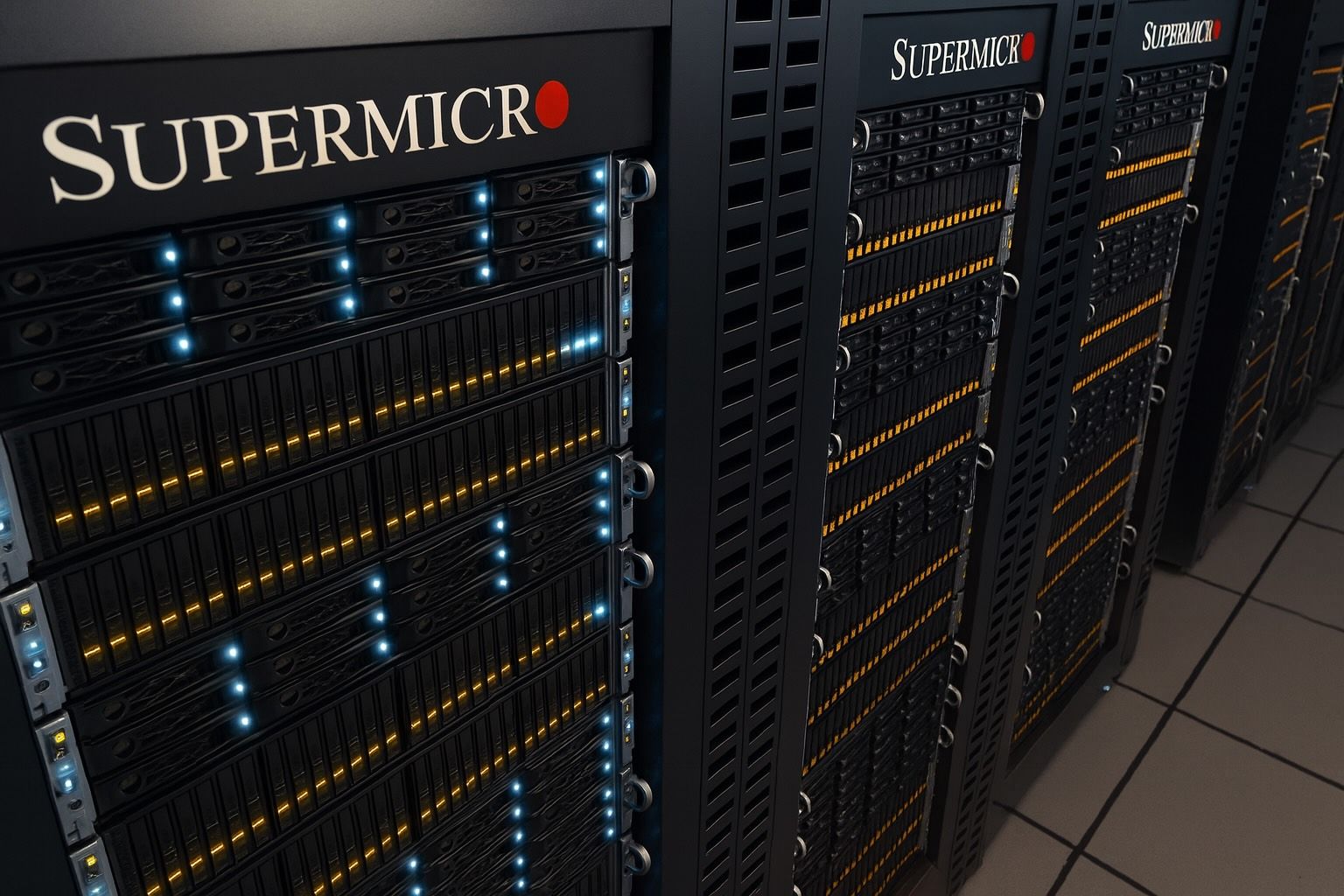- Solid but slowing fiscal 2025: Super Micro Computer’s fiscal‑2025 net sales were $22 billion, up from $7.1 billion two years earlier. Net income was $1.0 billion and GAAP diluted EPS $1.68 [1]. Fourth‑quarter revenue of $5.8 billion missed consensus and net income fell to $195 million (EPS $0.31), reflecting tariff‑related costs and weaker margins [2]. Gross margin declined from 10.2 % a year earlier to 9.5 % [3].
- Guidance trimmed: Management expects fiscal‑2026 net sales of at least $33 billion (down from an earlier $40 billion target) and Q1‑FY26 revenue of $6‑7 billion with non‑GAAP EPS $0.40‑0.52 [4]. Analysts forecast FY26 EPS around $1.86 [5].
- Shares remain volatile: SUPX shares surged ~44 % year‑to‑date following a year‑end slump but fell 15.5 % after the company missed Q4 estimates and lowered its outlook [6]. The stock’s meteoric rise during the AI boom has made it extremely sensitive to expectations—Morningstar notes the price jumped 1,300 % from late 2022 to March 2024 but subsequently dropped ~75 % [7].
- Analyst sentiment cautious: MarketBeat reports a consensus price target of $45.36 (range $27–$60) with a “Hold” rating [8]; Nasdaq finds the average analyst target is $39.15 with only three bullish ratings out of thirteen [9]. Several investment banks have cut targets due to margin pressure and competitive risks [10].
- AI‑infused growth story: The company’s modular server “building block” architecture and close relationship with NVIDIA place it at the heart of the AI data‑center build‑out. CEO Charles Liang highlighted that Super Micro has the “best track record for fast and successful deployments” of NVIDIA’s Blackwell AI platforms [11]. Management sees AI‑optimized servers as the company’s primary growth driver and is ramping liquid‑cooled designs to address high‑density workloads.
Review of SUPX Performance in 2025
Financial results
Super Micro Computer’s fiscal‑2025 (year ended June 30 2025) marked another year of explosive growth but also revealed some strains. Net sales for the full year jumped to $22 billion—almost triple revenue in FY‑2023. Fourth‑quarter revenue came in at $5.8 billion, missing analysts’ $5.88 billion estimate and reflecting slower hyperscale demand. Quarterly net income dropped to $195 million and diluted EPS $0.31, while full‑year net income reached $1.0 billion and EPS $1.68 [12].
The company’s gross margin narrowed to 9.5 % (from 10.2 % a year earlier) amid tariff‑related costs and price competition [13]. Cash flow from operations totaled $864 million in Q4, providing liquidity for capacity expansion [14].
Stock price and market reaction
SUPX shares entered 2025 battered by a 75 % decline from their March 2024 peak [15]. Investor enthusiasm returned in early 2025 as demand for AI servers surged; the stock rallied roughly 44 % year‑to‑date by late September [16]. The rally was fueled by news that Super Micro had begun volume shipments of NVIDIA’s Blackwell Ultra systems; CEO Charles Liang boasted that the company “has the best track record of fast and successful deployments of new NVIDIA technologies” [17]. However, Q4 results triggered a 15.5 % share slide when revenue and EPS missed estimates and management cut FY‑2026 guidance [18]. The stock remains highly volatile because even slight disappointments lead to outsized moves amid elevated expectations.
Major announcements and strategic moves
- AI‑focused products: Super Micro launched liquid‑cooled AI server platforms and started shipping NVIDIA Blackwell Ultra and Blackwell GPUs earlier than competitors. These systems are designed for generative‑AI workloads and emphasize thermal efficiency, reflecting industrywide shifts toward hybrid liquid cooling [19].
- Capacity expansion: Management continued to invest in global manufacturing capacity to meet AI demand, opening facilities in Malaysia and the United States. The company also announced partnerships to deliver full‑stack AI data‑center solutions and emphasised its modular “building block” strategy.
- Shareholder returns: Unlike some peers, Super Micro does not pay a dividend and reinvests profits into R&D and capacity expansion. It did not undertake large share repurchases, citing the need for capital to support growth.
Forecasts, Analyst Targets and Growth Potential
Wall Street’s view on SUPX has moderated after the Q4 earnings miss. MarketBeat tallied 19 analysts with an average price target of $45.36 (high $60, low $27), representing roughly 13 % downside from the current share price; the consensus rating is “Hold” [20]. Nasdaq’s compilation of thirteen analysts shows an even lower average target of $39.15 and notes that only three analysts are bullish, while most expect neutral or modest performance [21]. Price‑target cuts from J.P. Morgan (to $45) and Goldman Sachs ($27) reflect concerns about margin compression and potential market share losses [22]. Conversely, Needham raised its target to $60 on expectations that Super Micro’s scalable data‑center solutions will benefit from AI demand [23].
Looking ahead, management guides for FY‑2026 revenue of at least $33 billion with Q1‑FY26 revenue $6‑7 billion and non‑GAAP EPS $0.40‑0.52 [24]. Analysts project FY‑2026 EPS around $1.86 and expect earnings growth of about 19 % next year [25]. Growth drivers include continued AI server demand, expansion of liquid‑cooled systems, and increased international production. Risks include intensifying competition from Dell, HPE and Lenovo, margin pressure from tariffs and component costs, and cyclical downturns in hyperscale spending.
Recent News Affecting SUPX
- Blackwell Ultra shipments: In September 2025 Super Micro announced that it began volume shipment of NVIDIA’s Blackwell Ultra systems. CEO Charles Liang said the company has the “best track record” for fast deployment of new NVIDIA architectures, and the stock jumped 10 % over three sessions [26].
- Q4 FY25 miss: Reuters reported that Q4 revenue ($5.76 billion) and EPS ($0.41) fell short of analysts’ estimates, causing a 15.5 % share drop [27]. Analysts attributed the miss to share losses to larger rivals and high expectations after earlier strong quarters. Tariff‑related costs and slower hyperscale demand also weighed on results [28].
- Margin pressures: MarketWatch highlighted that gross margins slid to 9.5 % and that management cut the FY‑2026 revenue outlook from $40 billion to $33 billion [29]. Susquehanna analyst Mehdi Hosseini noted that margin pressure reflects increasing competition and rising operating expenses [30].
- Analyst downgrades: Several firms—including J.P. Morgan, Goldman Sachs and Citi—trimmed price targets due to concerns about supply‑chain constraints and market share erosion [31].
Comparative Analysis – SUPX versus Industry Peers
The table below compares Super Micro Computer with major competitors in the data‑center hardware and AI‑server space. All financials relate to fiscal‑year 2025 (or the most recent quarter for AMD) and are in U.S. dollars. Growth figures are year‑over‑year.
| Company (ticker) | FY2025 revenue / growth | Net income / EPS | Key highlights / AI exposure | Outlook & commentary |
|---|---|---|---|---|
| Super Micro Computer (SUPX) | $22 B revenue, +? % YoY; Q4 revenue $5.8 B [32]. | FY net income $1.0 B, EPS $1.68 [33]; Q4 EPS $0.31 [34]. | Pure‑play server maker focusing on modular AI‑optimized systems; leading supplier of NVIDIA’s Blackwell platforms; gross margin declined to 9.5 % [35]. | FY‑26 guidance trimmed to ≥$33 B revenue and EPS $0.40‑0.52 in Q1 [36]; high volatility and analyst price targets around $39‑45 [37] [38]. |
| Dell Technologies (DELL) | FY2025 revenue $95.6 B, up 8 % [39]; Infrastructure Solutions Group (ISG) revenue $43.6 B, +29 %; Q4 revenue $23.9 B [40]. | Operating income $6.2 B (up 15 %); diluted EPS $6.38 (up 39 %) [41]. | Strong data‑center business—servers & networking revenue $6.6 B, +37 % [42]; invests heavily in AI‑optimized servers. | Guides FY‑26 revenue growth of 8 % and EPS growth 23 % [43]; raised dividend and share‑repurchase authorization. |
| Hewlett Packard Enterprise (HPE) | Q3 FY25 revenue $9.1 B, +19 % YoY [44] (annual results not yet published). | GAAP EPS $0.21; non‑GAAP EPS $0.44 [45]. | Servers (Compute) revenue $4.9 B (+16 %) and Networking revenue $1.7 B (+54 %); shifting to as‑a‑service model [46]. | Guides Q4 revenue $9.7–$10.1 B and non‑GAAP EPS $0.56–0.60, FY25 EPS $1.88–1.92 [47]. |
| Lenovo Group (LNVGY) | FY2024/25 revenue $69.1 B, +21 % YoY [48]; Q4 revenue $17 B, +23 % [49]. | Net income $1.4 B, +36 % [50]. | Infrastructure Solutions Group achieved >60 % revenue growth and profitability; emphasising “AI PC” and hybrid AI strategy [51]. | Focuses on edge‑to‑cloud AI, invests in R&D ($2.3 B, +13 %) [52]; benefits from diversified PC and data‑center segments. |
| NVIDIA (NVDA) | FY2025 revenue $130.5 B, +114 % YoY; Q4 revenue $39.3 B (record) [53]. | FY GAAP EPS $2.94 (up 147 %); Q4 diluted EPS $0.89 [54]. | Dominant AI chip supplier; data‑center revenue $35.6 B in Q4 (+16 % QoQ); CEO Jensen Huang sees “agentic and physical AI” driving next wave [55]. | Riding generative‑AI demand; heavy investment required to maintain capacity; faces supply‑chain constraints. |
| AMD (AMD) | Q2 2025 revenue $7.7 B (record); Data‑Center segment revenue $3.2 B, +14 % YoY [56]. | GAAP net income $872 M, EPS $0.54 [57]. | Strong demand for EPYC processors and AI accelerators; Client & Gaming segment revenue $3.6 B (+69 %) [58]. | CEO Dr. Lisa Su expects long‑term growth driven by AI; export controls remain a headwind [59]. |
Industry Landscape – AI, Servers and Data‑Center Hardware in 2025
Artificial‑intelligence workloads are reshaping the data‑center hardware sector. JLL’s 2025 Global Data Center Outlook notes that AI demand is creating record levels of data‑center construction but that power transmission constraints and long lead times for utility connections are causing project delays [60]. The report anticipates $170 billion of data‑center asset financing needs in 2025 and observes a growing enthusiasm for small‑modular nuclear reactors as a solution to energy‑supply challenges [61]. GPUs used in AI training now consume 300 % more power than prior generations, pushing data‑center energy demand to double within five years [62]. Consequently, operators are shifting to hybrid liquid cooling (70 % liquid, 30 % air) to manage high‑density racks [63].
Brightlio notes that the global data‑center market could reach $527.46 billion by 2025, fueled by cloud computing expansion, edge computing and AI/ML adoption [64]. Hyperscale providers such as AWS, Microsoft and Google are scaling operations to meet AI workloads, while hardware vendors like NVIDIA, Dell and Super Micro deliver AI‑specific servers [65]. The article emphasises that advanced cooling systems are essential for high‑performance GPUs and that sustainability (including renewable energy) is becoming a competitive differentiator [66].
These trends create opportunities and risks for Super Micro. Demand for AI‑optimized servers should remain strong as more enterprises adopt generative AI and model training intensifies. However, supply‑chain bottlenecks, energy constraints and intensifying competition from deep‑pocketed rivals (Dell, HPE, Lenovo, NVIDIA) could erode margins. Regulatory changes (e.g., U.S. export controls on high‑end chips) may also limit sales to China and other markets.
Expert Commentary
- Charles Liang (Super Micro CEO): Liang stated that Super Micro has the “best track record of fast and successful deployments of new NVIDIA technologies,” underscoring the company’s close ties to NVIDIA and its ability to deliver AI solutions quickly [67]. He expects AI‑optimized servers to drive continued growth as generative‑AI workloads proliferate.
- Mehdi Hosseini (Susquehanna analyst): In a MarketWatch interview, Hosseini warned that Super Micro’s shrinking gross margin and increased operating expenses signal rising competition; he sees limited upside unless margins stabilize [68].
- Gil Luria (D.A. Davidson analyst): After the Q4 miss, Luria told Reuters that some customers may prefer larger vendors like Dell and HPE, which could lead to share losses for Super Micro [69].
- Bokeh Capital CEO Kim Forrest: Forrest observed that investors have lofty expectations for AI‑focused companies, so any softness in results triggers large stock declines [70]. This dynamic explains SUPX’s post‑earnings volatility.
Conclusion – Outlook for Investors
Super Micro Computer entered 2025 as a darling of the AI boom, delivering triple‑digit growth and capturing market share with its flexible, modular server designs. Fiscal‑2025 results confirmed the company’s ability to convert AI hype into revenue: net sales surged to $22 billion and cash generation remained strong [71]. Yet the Q4 miss and lowered guidance exposed vulnerabilities. Margins compressed to 9.5 % [72], and competition from better‑capitalized rivals is intensifying. Analysts have tempered expectations, with consensus price targets in the low‑$40s and a “Hold” recommendation [73] [74].
The long‑term opportunity remains compelling: AI workloads continue to accelerate, data‑center construction is booming, and liquid‑cooled server architectures are becoming essential. Super Micro’s deep integration with NVIDIA and nimble engineering give it a chance to capture a meaningful slice of this market. However, investors should brace for volatility. The stock’s meteoric rise has created a high bar for earnings, and supply‑chain disruptions or competitive pricing could quickly erode margins. For long‑term investors with high risk tolerance, SUPX offers exposure to the AI infrastructure theme; those seeking steadier returns may prefer diversified peers like Dell or HPE.
In summary, 2025 proved a pivotal year for Super Micro Computer (SUPX). The report notes the company’s explosive top-line growth to $22 billion in revenue and its deep ties to NVIDIA, but also highlights margin compression, tariff pressures, and heightened competition. Analysts lowered their consensus price target into the $40 range as management trimmed FY26 guidance to at least $33 billion [75]. Despite a roughly 44 % YTD rally fueled by early shipments of Blackwell Ultra systems, the stock remains volatile, with a 15.5 % plunge after missing Q4 expectations [76].
The report concludes that Super Micro’s long-term prospects hinge on continued AI server demand, advances in liquid-cooling technology, and the company’s ability to fend off giants like Dell and HPE. While the AI-driven data center market could reach $527 billion by 2025 [77], supply-chain bottlenecks and energy constraints pose material risks. Overall, SUPX offers high-octane exposure to AI infrastructure but suits investors with a strong appetite for volatility and an awareness of emerging competitive dynamics.
References
1. ir.supermicro.com, 2. ir.supermicro.com, 3. www.morningstar.com, 4. ir.supermicro.com, 5. www.marketbeat.com, 6. www.reuters.com, 7. www.morningstar.com, 8. www.marketbeat.com, 9. www.nasdaq.com, 10. capital.com, 11. www.morningstar.com, 12. ir.supermicro.com, 13. www.morningstar.com, 14. ir.supermicro.com, 15. www.morningstar.com, 16. www.morningstar.com, 17. www.morningstar.com, 18. www.reuters.com, 19. www.jll.com, 20. www.marketbeat.com, 21. www.nasdaq.com, 22. capital.com, 23. capital.com, 24. ir.supermicro.com, 25. www.marketbeat.com, 26. www.morningstar.com, 27. www.reuters.com, 28. www.reuters.com, 29. www.morningstar.com, 30. www.morningstar.com, 31. capital.com, 32. ir.supermicro.com, 33. ir.supermicro.com, 34. ir.supermicro.com, 35. www.morningstar.com, 36. ir.supermicro.com, 37. www.marketbeat.com, 38. www.nasdaq.com, 39. www.dell.com, 40. www.dell.com, 41. www.dell.com, 42. www.dell.com, 43. www.dell.com, 44. www.hpcwire.com, 45. www.hpcwire.com, 46. www.hpcwire.com, 47. www.hpcwire.com, 48. news.lenovo.com, 49. news.lenovo.com, 50. news.lenovo.com, 51. news.lenovo.com, 52. news.lenovo.com, 53. nvidianews.nvidia.com, 54. nvidianews.nvidia.com, 55. nvidianews.nvidia.com, 56. ir.amd.com, 57. ir.amd.com, 58. ir.amd.com, 59. ir.amd.com, 60. www.jll.com, 61. www.jll.com, 62. www.jll.com, 63. www.jll.com, 64. brightlio.com, 65. brightlio.com, 66. brightlio.com, 67. www.morningstar.com, 68. www.morningstar.com, 69. www.reuters.com, 70. www.reuters.com, 71. ir.supermicro.com, 72. www.morningstar.com, 73. www.marketbeat.com, 74. www.nasdaq.com, 75. ir.supermicro.com, 76. www.reuters.com, 77. brightlio.com










